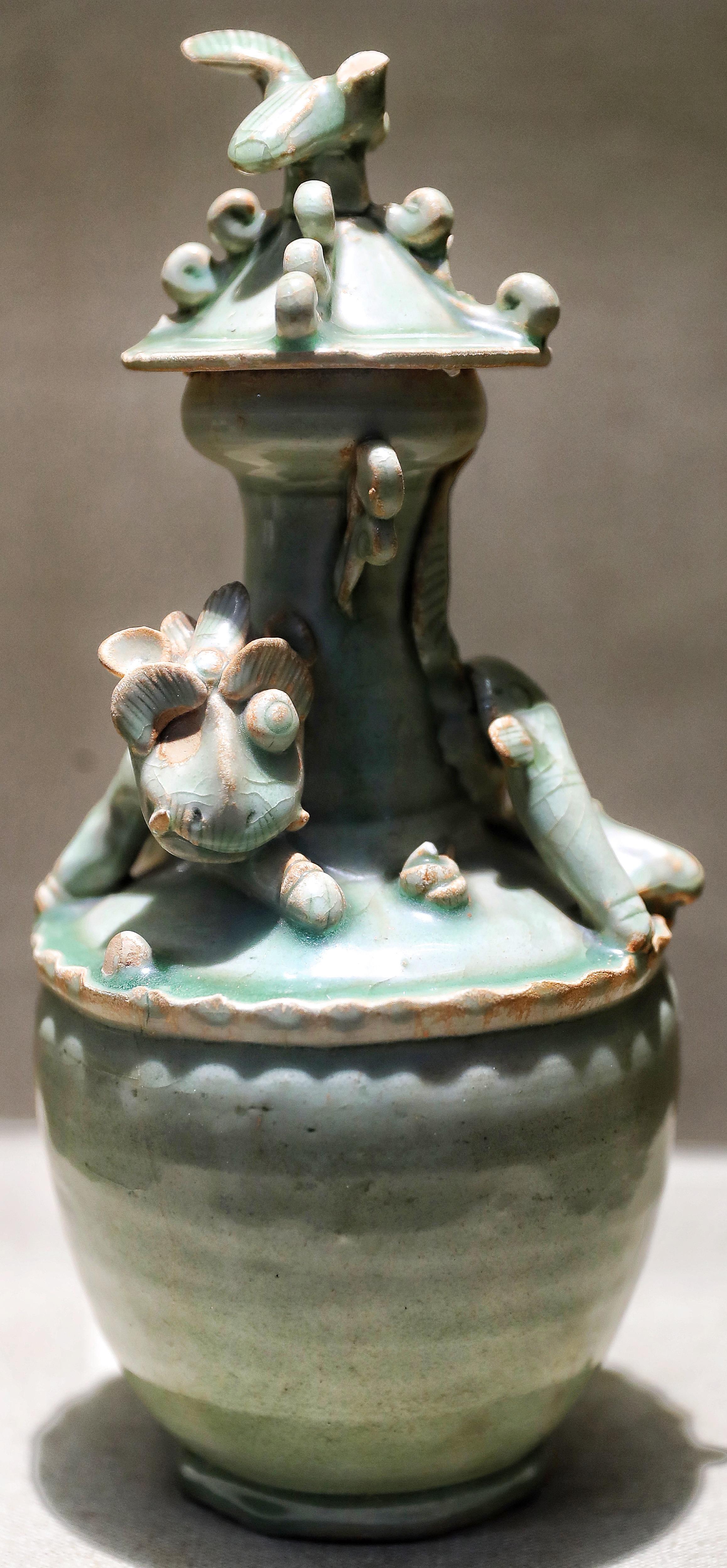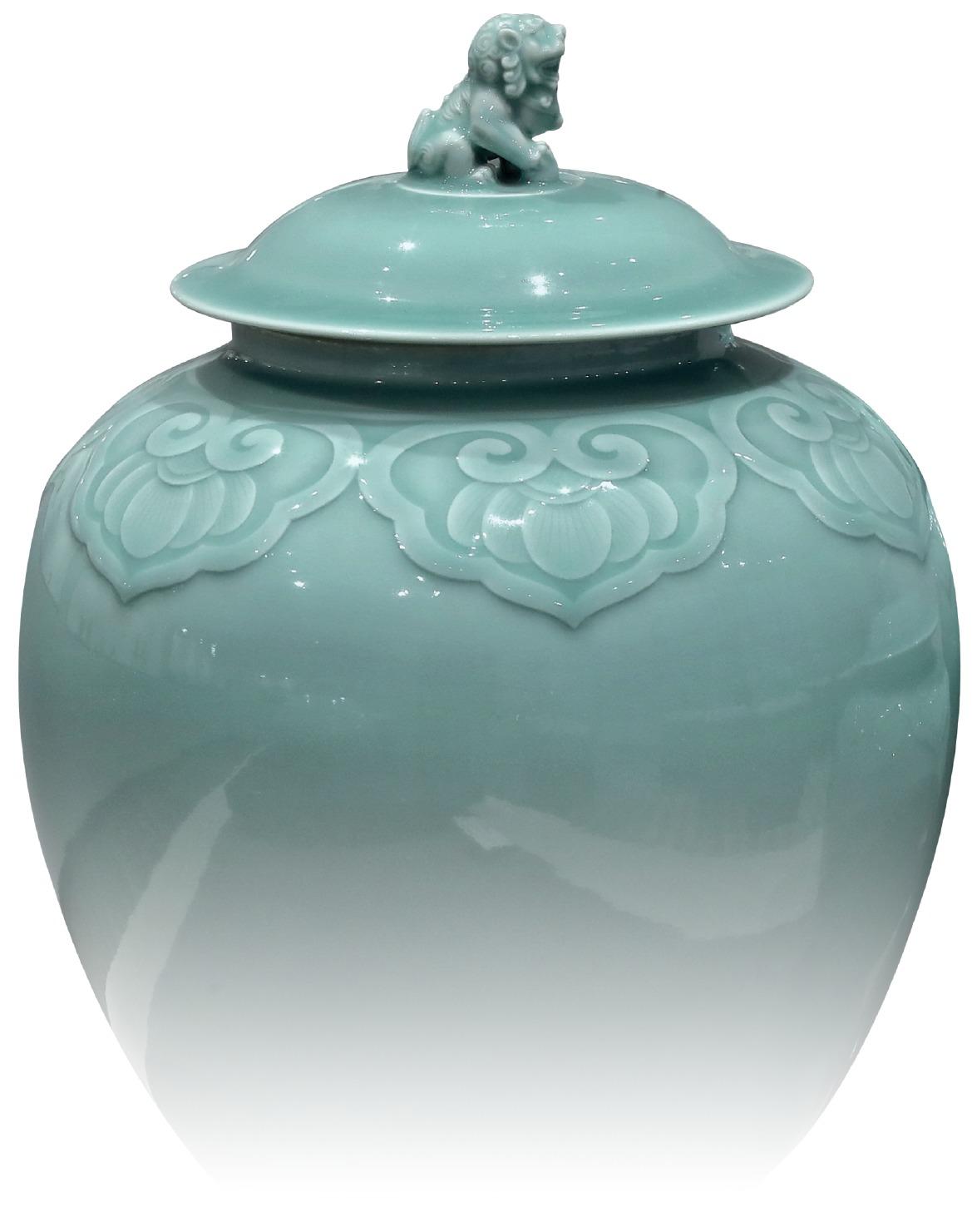Exquisite craftsmanship and design were hallmarks from the outset of a product always in global demand, Deng Zhangyu and Ma Zhenhuan report.
 Tea cups (above) and a jar produced by Longquan celadon artisan Yang Leping. (JIANG DONG / CHINA DAILY)
Tea cups (above) and a jar produced by Longquan celadon artisan Yang Leping. (JIANG DONG / CHINA DAILY)
How would a celadon craftsman in Longquan, Zhejiang province, have spent his day hundreds of years ago when the jade-green porcelain produced there was the center of a global frenzy?
He likely had to keep working day and night to produce as many pieces as possible to meet orders from Persia, Japan and India. Most probably, he had to ask family members and relatives to help with the heavy workload.
The charm of ceramic lies in more than its beauty. You can find it embodies poetry, painting, calligraphy, literature, engraving and to some extent, the most advanced techniques of the time.
Guo Canjiang, porcelain expert at the Henan Museum in Zhengzhou
Ceramics recovered from shipwrecks in ancient ports worldwide are testament to the large quantities of celadon exported to other parts of Asia, Europe and East Africa, according to Liu Ying, director of the Celadon Museum in Longquan.
The export of Longquan celadon peaked during the Yuan Dynasty (1271-1368). According to historical records, about 80 percent of the ceramics exported from China at the time were the green-colored pottery made in Longquan.
"It was like the iPhone of ancient China, a popular commodity sought after by people across the world," says Liu.
An ongoing show at the Longquan Celadon Museum features porcelain relics found at the al-Mataf site, an ancient port ruin in Ras al-Khaimah in the United Arab Emirates. The finds from the harbor, where ships stopped after entering the Gulf, were compared to 30 similar pieces housed in the Palace Museum in Beijing.
A scientific analysis of the finds from the al-Mataf site shows their similarity to those produced in China at the same time, including Longquan celadon. The analysis was conducted in 2018 by a Chinese archaeological team led by Wang Guangyao, a porcelain expert from the Palace Museum.
After three years of excavation and study at al-Mataf, which was along one of the world's busiest maritime trade routes a millennium ago, Wang says their work proves that Longquan celadon and blue-and-white ceramics were the two main types of porcelain exported centuries ago.
"Together with silk and tea, ceramics were one of the three major goods supporting ancient China's export trade," says Wang, who has studied porcelain for more than three decades.
 A statue of a Buddhist deity dating to the Yuan Dynasty (1271-1368). (JIANG DONG / CHINA DAILY)
A statue of a Buddhist deity dating to the Yuan Dynasty (1271-1368). (JIANG DONG / CHINA DAILY)
In the Tang Dynasty (618-907), ceramics produced in China began to appear in overseas markets. A wide range of ceramic products, including bowls, dishes, pots and vases, were transported across the world overland, and via the ancient Maritime Silk Road.
They were named after their country of origin, to illustrate their uniqueness and that they could only be bought from China. Before the Germans learned how to successfully re-create porcelain at the beginning of the 18th century, China was the only place able to produce these popular vessels.
"The history of the export of ceramics is also a history of cultural and technological exchange between China and the world," says Wang.
Before the 14th century, China controlled the production of high-quality porcelain and was a seller-oriented market. Finds unearthed from Taicang, an ancient port in Suzhou, Jiangsu province, show that celadon from Longquan was transported without being taken out of its firing boxes.
 A vase with tiger design from the Southern Song Dynasty (1127-1279). (JIANG DONG / CHINA DAILY)
A vase with tiger design from the Southern Song Dynasty (1127-1279). (JIANG DONG / CHINA DAILY)
During the process of firing, celadon pieces were placed in pottery boxes which would protect them from the ashes. Usually half of the products were usable while the rest broke or were defective.
"Whether they were good or bad, merchants took them all. This reflects how much demand there was on the market then," says Liu.
From the Ming Dynasty (1368-1644) onward, the export of blue-and-white porcelain sparked a global fascination with these precious treasures from the East. Chinese porcelain makers began to produce pieces tailored to tastes in different countries after noticing a preference for kendis, a kind of water pot with a curved spout, in Southeast Asia, and began to produce for markets in places like Malaysia and Thailand.
"It was a phenomenon of cultural exchange, with merchants from the Middle East flooding into China," says Wang.
 A Southern Song Dynasty vase with dragon design. (JIANG DONG / CHINA DAILY)
A Southern Song Dynasty vase with dragon design. (JIANG DONG / CHINA DAILY)
In fact, blue-and-white porcelain was itself influenced by the Islamic world's taste. Several emperors in the 15th century are known to have supported Islam, and the Muslim favoring of blue and white influenced the whole porcelain industry.
Wang says the materials used to produce blue-and-white porcelain was imported from Persia during the early stage of its development.
From the 16th century, Kraak porcelain, a blue-and-white porcelain tailored for overseas markets only, was fired on a large scale in kilns in Fujian province. Though the word kraak is Dutch, it is believed to derive from the Portuguese ships (carracks) that transported it. Kraak ware was made in the shape of deep bowls or wide dishes, whose surfaces were divided into segments and painted with motifs.
The 18th century saw increasing orders for blue-and-white armorial porcelain from the royal families and aristocrats of Europe. They usually bore the crests of the families painted at the center and were used on special occasions.
"On porcelain, you can find all the popular elements and trends from around the world," says Wang.
 Tea cups and a jar (above) produced by Longquan celadon artisan Yang Leping. (JIANG DONG / CHINA DAILY)
Tea cups and a jar (above) produced by Longquan celadon artisan Yang Leping. (JIANG DONG / CHINA DAILY)
For instance, the blue-and-white porcelain production in Jingdezhen, Jiangxi province, featured technology from different parts of the world, which was then evolved and eventually spread across the globe.
During the late Qing Dynasty (1644-1911), under the influence of the West, Chinese porcelain was being made in colors other than the green favored by the Song Dynasty (960-1279).Some makers used glass and enamel techniques introduced from Europe to produce the multicolored ceramics loved by the imperial family at the Forbidden City.
"China has a 3,000-year history of ceramic making. Our porcelain has absorbed influences from other cultures to enhance itself over generations," Wang says.
Guo Canjiang, a porcelain expert at the Henan Museum in Zhengzhou, says that ceramic is a perfect combination of vessel and culture. From house ware used in ordinary daily life, to artifacts appreciated and collected by the upper classes, it links reality with the spiritual world.
"The charm of ceramic lies in more than its beauty. You can find it embodies poetry, painting, calligraphy, literature, engraving and to some extent, the most advanced techniques of the time," Guo says.
Contact the writers at dengzhangyu@chinadaily.com.cn


